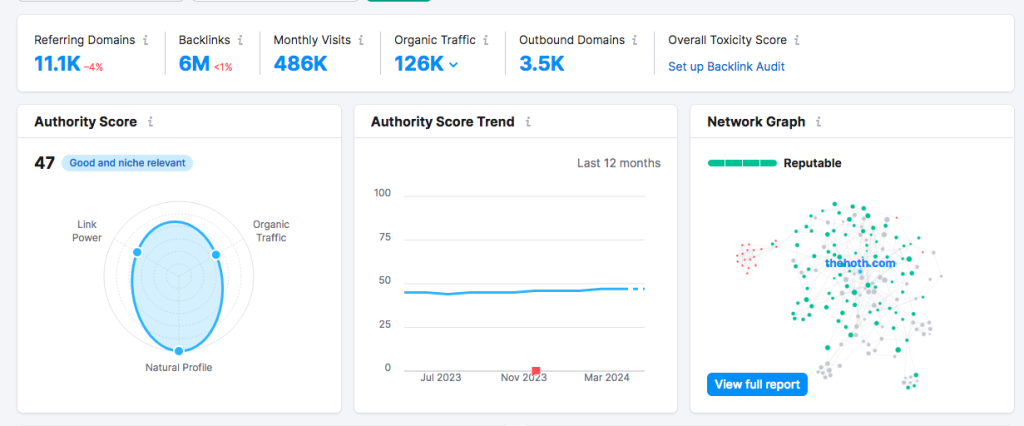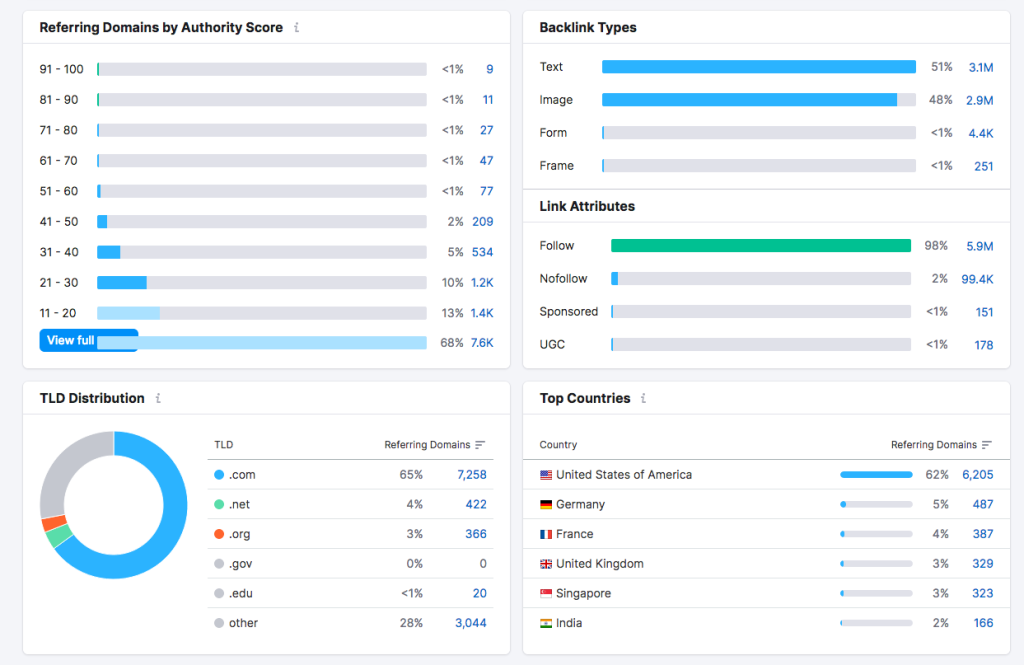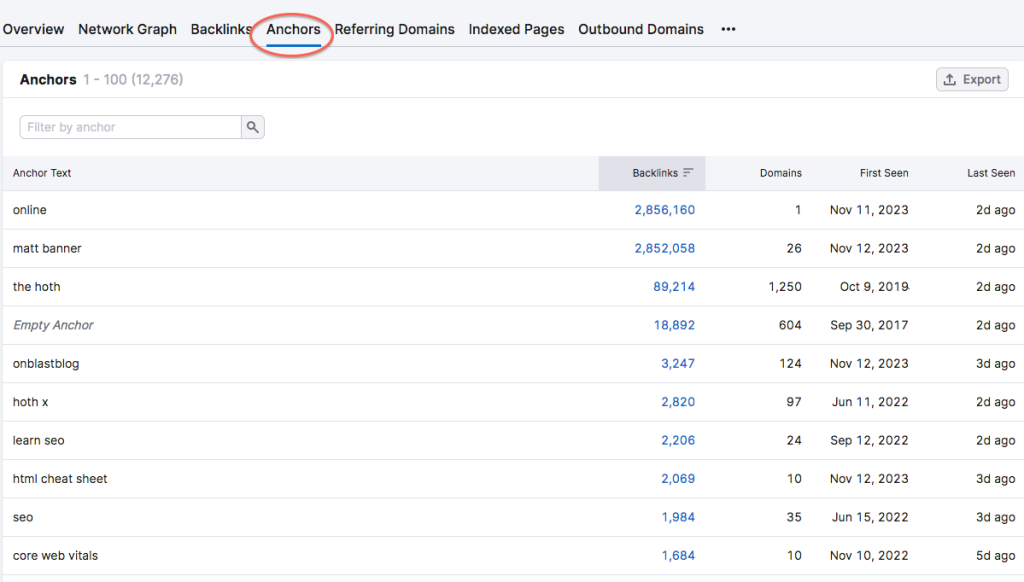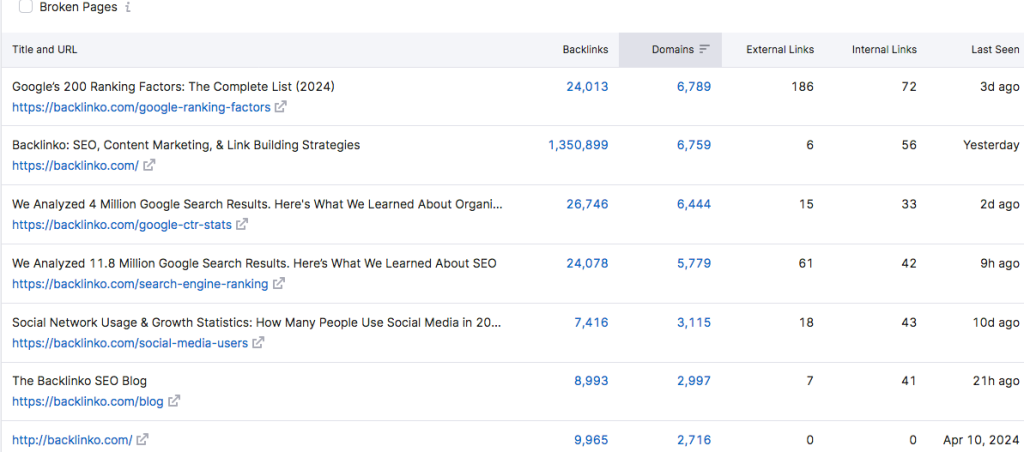If you want to reach the top of Google and stay there, then you’ll need a stronger backlink profile than your competitors.
Backlinks are one of the most important ranking factors for Google’s search algorithm, so you’ll need to take part in link-building if you want to reach the #1 position.
The only problem is building links is a time-consuming process that can be downright confusing.
However, if you use Semrush for link-building, you’ll have access to a fleet of tools that contain features for:
- Uncovering top-tier backlink opportunities in your field
- Auditing your current link profile to ensure it’s in tip-top shape
- Identifying the exact number of links you need to close the gap with competitors
- Conduct, automate, and monitor link-building outreach campaigns
In other words, these tools will transform you into a link-building extraordinaire.
According to research, the #1 search result contains an average of 3.8x more backlinks than positions #2 – #10, which is a testament to the ranking power backlinks provide.
That’s why it’s worth learning how to use Semrush’s tools for link-building, and that’s exactly what we’re going to teach you in this article, so stay tuned.
An Overview Of Semrush’s Link-Building Tools
Here’s a glimpse at all the link-building tools you gain access to with a subscription to Semrush:
- Backlink Analytics. This tool provides a general overview of your backlink profile, including any new or lost links. The Analytics tool features the largest and fastest link database on the market and provides extremely accurate competitor data.
- Backlink Audit. With the Audit tool, you’ll be able to avoid Google penalties by getting rid of any harmful links. It’s also a useful tool for ensuring the quality of your link placements.
- Backlink Gap. How many links do you need to build to bridge the gap between you and a competitor? That’s the central question this tool answers.
- Bulk Backlink Analysis. One of the most annoying aspects of link-building is how time-consuming it is. This tool eliminates that problem by analyzing competitor websites and new link opportunities in bulk.
- Link-Building Tool. Conducting outreach is cumbersome, and it’s easy to lose track of if you’re not using a central tool like Semrush. The link-building tool serves as your central hub for your link-building campaigns, as you can manage and automate your outreach efforts.
Now that you’ve taken a peek inside the toolbox, let’s learn some of the best ways to use Semrush to improve your link-building campaigns.
Checking What’s New With Your Link Profile (Backlink Analytics)
It’s crucial to keep an eye on your website’s backlink profile, as it’s subject to change quite often. Try to check it at least once per week, especially if you’re actively trying to build more links.
The Backlinks Analytics Report is what you want to use to check on your link profile, including any new developments.
You’ll be able to see if your outreach efforts paid off by selecting New and Follow (to only show dofollow links) from the filters list.
Yet, if you’ve been building press links, you’ll also want to include Nofollow links to see if you picked up anything new.
Other important metrics in this report are:
- Your authority score
- Total number of referring domains and backlinks
- Monthly visits
- Organic traffic
Further down the page, you’ll find insightful features like your TLD (top-level domain) distribution, top countries, backlink types, and link attributes.
Find and Recover Lost Backlinks
Not all backlinks last forever, which is an unfortunate fact of life. However, Semrush keeps track of all the links you lost via the Lost backlinks filter on the Analytics Report.
There are a number of reasons why you may lose a backlink.
It could be that the site owner moved the page containing the link but forgot to add a redirect, resulting in a 404 Not Found.
Or it might be that a competitor convinced them to use one of their links instead.
Whatever the case may be, you can use the Lost Backlinks filter to quickly identify your lost backlinks. Not only that, but the report will even tell you what the issue is, such as a broken domain, page redirect, or if the site owner removed the link manually.
Once you know which links you lost, you can reach out to the site owners and hopefully convince them to resurrect your backlink.
Audit Your Anchor Text Profile
The anchor text (the text masking the URL) you use matters to Google, and it’s important to have a balanced anchor text profile.
In particular, you want to avoid using ‘exact match’ anchor text too often.
That’s where your anchor text consists of a keyword important to your business and nothing else. This screams spam to Google, so it’s best to use exact match anchor text sparingly.
A better bet is to use ‘partial match’ anchor text, where you combine keywords with other phrases. Branded anchor text and naked URLs should also be thrown into the mix.
Semrush makes managing your anchor text effortless with the Anchors report in its Backlink Analytics tool.
Here, you’ll be able to view a breakdown of the different types of anchor text your backlinks have, which will help you determine if you’re using too much of one type.
Set up Automated Notifications for Your Backlinks
Semrush’s Backlink Audit tool features an extremely handy notification feature.
It will notify you via email any time there’s a change to your link profile, including:
- Acquiring a new backlink
- Losing a backlink
- Broken domains
Turning on notifications will ensure that you’re fast to act on lost backlinks and broken domains, which is essential for maintaining a healthy link profile.
Find Valuable Content Ideas from Competitors
One of the best ways to build links without going nuts conducting outreach is to create outstanding content that naturally attracts links from other websites.
Yet, that’s often easier said than done, as it can be tricky to know which type of content to create.
Semrush’s Indexed Pages report is your secret weapon for uncovering content ideas that generate links.
This time, you’ll want to enter a competitor’s URL into the tool instead of your own. Once that’s done, navigate to the Indexed Pages report to see the web pages that have generated the most backlinks for them.
From there, take notes on which content types attracted the most links, and then create similar content for your brand.
Try Out Semrush With an Exclusive 14-Day Free Trial
Those are only a few ways you can use Semrush’s tools to improve your link-building campaigns.
The platform contains a comprehensive suite of SEO tools, and we’ve only scratched the surface.
If you’re ready to see what Semrush can do for your business, don’t wait to take advantage of our exclusive offer – an extended 14-day trial of Semrush Pro. The standard trial only lasts 7 days, so don’t forget to use our special link!
The post How to Use Semrush for Link-Building: Tools and Strategies appeared first on The HOTH.
Go to Source
Author: Chloe Jost





